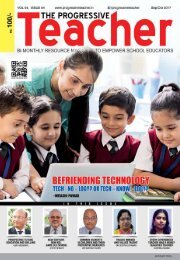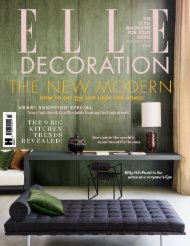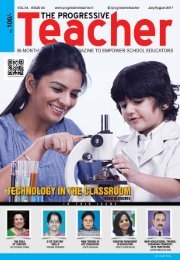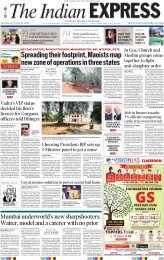revised_tpt_may_june_17 combine
You also want an ePaper? Increase the reach of your titles
YUMPU automatically turns print PDFs into web optimized ePapers that Google loves.
learning styles<br />
UNDERSTAND HOW YOU LEARN BEST<br />
Learning style is an individual’s natural pattern of acquiring and processing information in<br />
learning situations. For improving your learning efficiency is to recognize your learning habits<br />
and styles.<br />
–Manmeet Kaur Reen<br />
Students learn in many ways and<br />
research has shown that students can<br />
perform better on tests if they change<br />
study habits to fit their own personal learning<br />
styles. Some remember things they’ve seen,<br />
some what they’ve heard, while others<br />
remember things they’ve experienced. But for<br />
most students, one of these methods stands<br />
out.<br />
For example, visual – learning students will<br />
sometimes struggle during essay exams,<br />
because they can’t recall test material that<br />
was ‘heard’ in a lecture. However, if the visual<br />
learner uses a visual aid when studying, like<br />
colorful outline of test materials, he or she<br />
<strong>may</strong> retain more information. For this type<br />
of learner, visual tools improve the ability to<br />
recall information more completely.<br />
There are three main types of learning styles:<br />
auditory, visual, and kinesthetic. Most people<br />
learn best through a combination of the three<br />
types of learning styles, but everybody is<br />
different.<br />
Auditory learners: Hear<br />
Auditory learners are those who learn best<br />
through hearing things.<br />
Some important characteristics of<br />
an auditory learner:<br />
• Follows spoken directions well.<br />
• Is good at explaining.<br />
• Remembers names.<br />
• Likes to read self out loud.<br />
• Not afraid to speak in the class.<br />
• Notices sound effects in movies.<br />
• Enjoys music.<br />
• Can’t keep quiet for long periods.<br />
• Enjoys acting, being on stage.<br />
• Reads slowly.<br />
Activities for auditory learner:<br />
• Oral presentations<br />
• Tape recordings<br />
• Panel discussion<br />
• Verbal games<br />
• Debates<br />
Manmeet Kaur Reen holds a degree in Home Science, M.Sc<br />
in Child Development, Advanced Post Graduate Diploma in<br />
Child Guidance and Family Counseling, M.A in Psychology,<br />
B.Ed, and has also done a course in Learning Disability.<br />
She loves teaching, to inspire young minds to develop<br />
their unique personalities. She believes a good teacher<br />
is someone who enjoys what he/she does and has the<br />
ability to receive and give feedback to support learning<br />
among students to make studies joyful and enable students<br />
to grow. She likes to write articles for newspapers, magazines and journals<br />
concerning areas related to education, parents and adolescents.<br />
She is currently working as a PGT Home Science Teacher in Doon International<br />
School, Mohali.<br />
May/Jun 20<strong>17</strong><br />
• Oral recitation<br />
• Demonstrations<br />
• Poems/songs<br />
Highlights for teachers:<br />
Learns best by verbal instructions.<br />
Easily distracted by noise.<br />
Visual learners: See<br />
Visual learners are those who learn best<br />
through what they read and write. They<br />
understand information best when they SEE IT.<br />
Some important characteristics of<br />
a visual learner:<br />
• Prefer to see the words written down.<br />
• Prefer a diagram to remember historical<br />
events.<br />
• Prefer written instructions rather than<br />
verbal instructions.<br />
• Observes all the physical elements in a<br />
classroom.<br />
• Prefers photographs and illustrations with<br />
printed content.<br />
• Remembers and understands through the<br />
use of diagrams, charts and maps.<br />
• Studies materials by reading notes and<br />
organizing it in outline form.<br />
• Enjoys visual art activities.<br />
Activities for visual learner:<br />
Illustrations, diagrams, photographs<br />
PowerPoint presentation<br />
Posters, collages<br />
Movies, games<br />
Flash cards<br />
Writing , reading<br />
Highlights for teachers:<br />
Learns best by writing down things (taking<br />
notes).<br />
Most visual learners learn best alone.<br />
Use charts, maps, posters, power point<br />
presentations, videos, computer.<br />
Kinesthetic learners: Touch<br />
Kinesthetic learners remember what they<br />
DO, what they experience with their hands<br />
i.e. they learn best through things they<br />
experience.<br />
Some important characteristics of<br />
a kinesthetic learner:<br />
• Remember what they do.<br />
• Enjoys making and creating.<br />
• Enjoys using computers.<br />
• Has trouble staying still for a long time.<br />
• Enjoys hands-on activities.<br />
• Fiddle with small objects while listening<br />
or working.<br />
Activities for Kinesthetic learner:<br />
Role play /interviews<br />
Plays<br />
Projects<br />
Science labs<br />
Surveys<br />
Cut –and –paste tasks<br />
Demonstrations<br />
Field trips<br />
Highlights for teachers:<br />
Encourage to write down their notes.<br />
Allow to take breaks during lessons.<br />
Incorporate multimedia resources.<br />
Knowing and understanding the types of<br />
learning styles is important for students<br />
of any age. It is advantageous for students<br />
to understand their type of learning style<br />
early on so that homework and learning <strong>may</strong><br />
become easier and less stressful in<br />
the future.<br />
www.progressiveteacher.in 19







